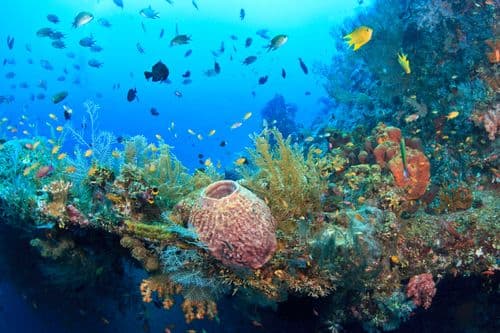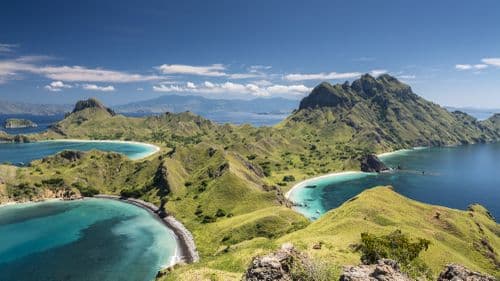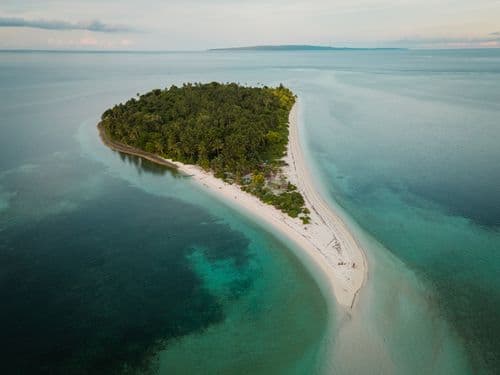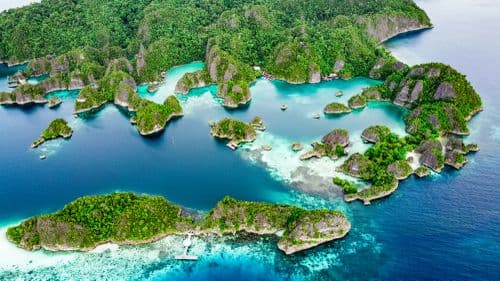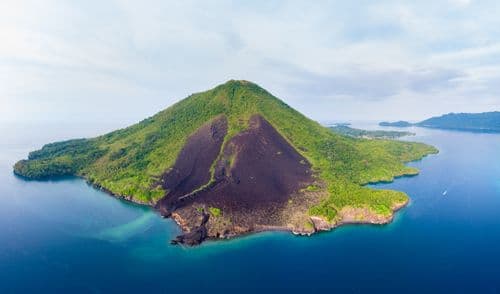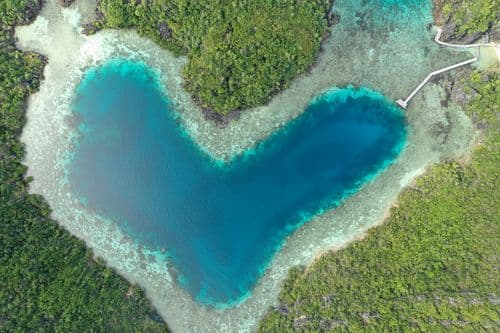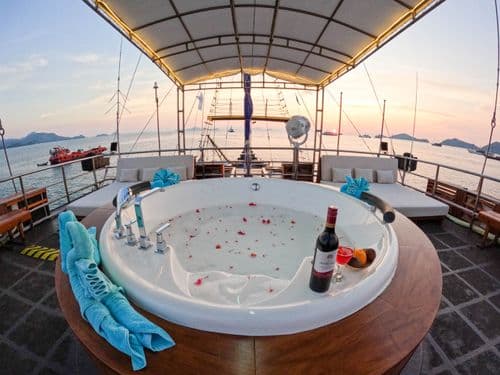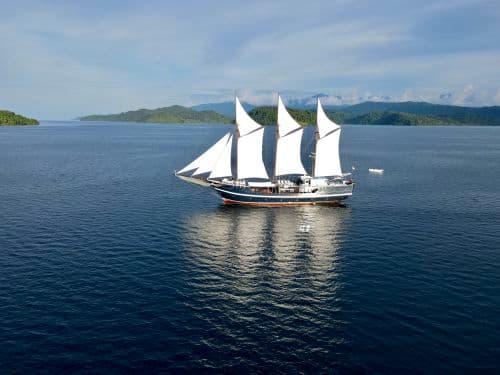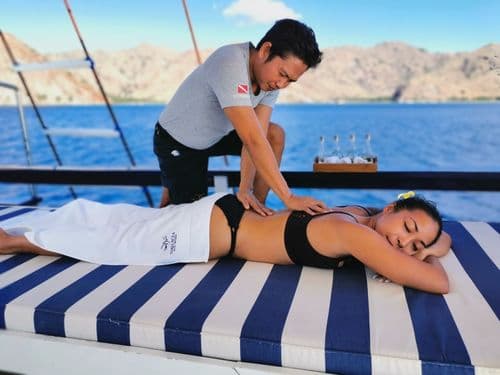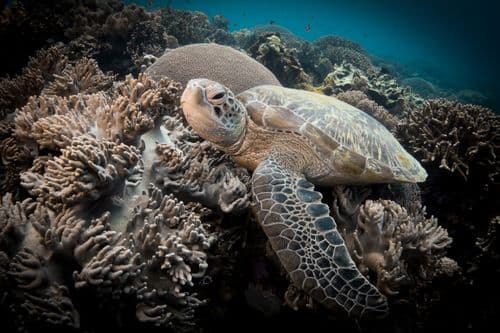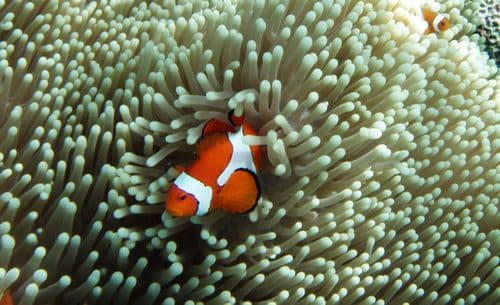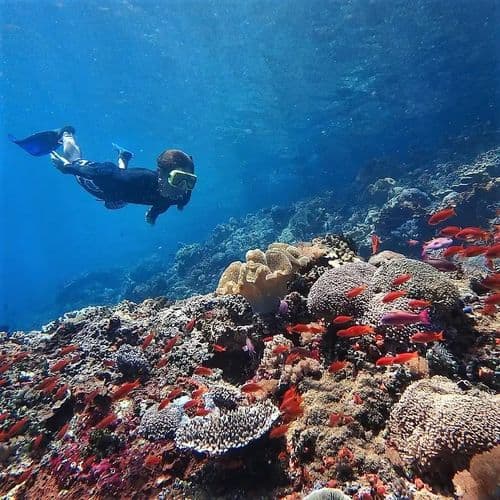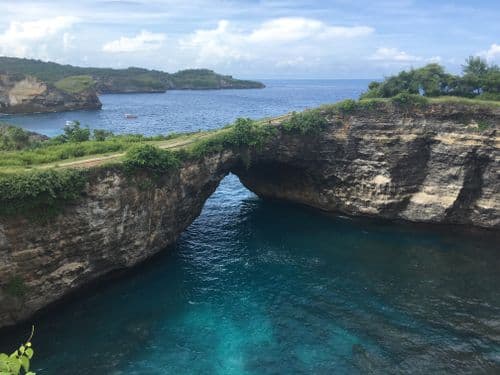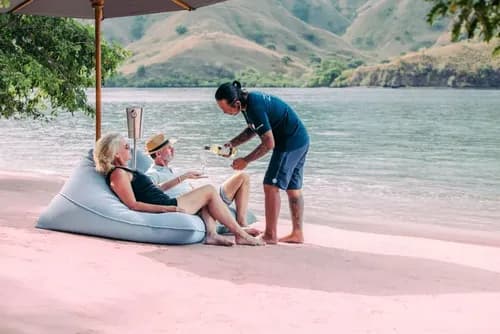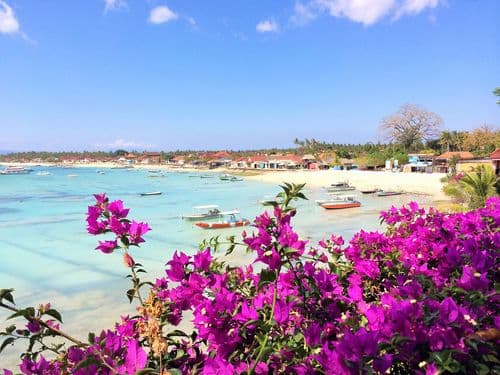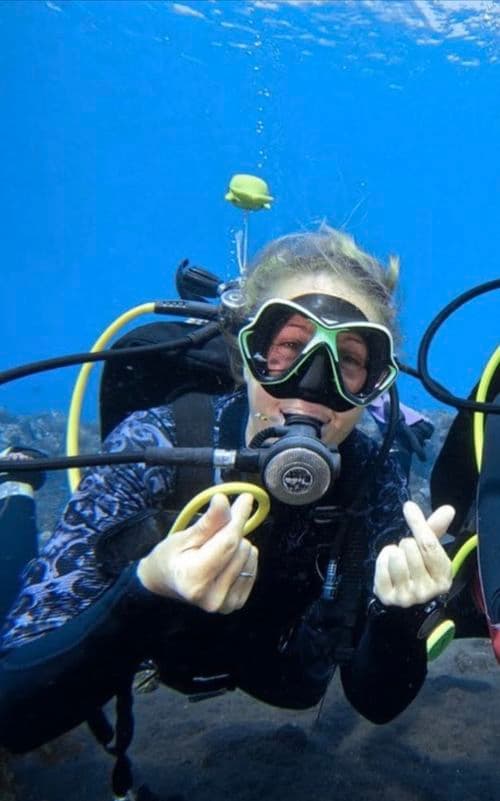
Raja Ampat
A 9-day liveaboard expedition on board the Tiaré
Length
9 Days
Ship category
Luxury
Ship type
Phinisi Yacht
Capacity
14 Passengers
Raja Ampat
2 Reviews
Trip highlights
Observe manta rays up close
Climb to the top of Penemu Island
Witness over 374 fish species during a single dive
Discover the very traditional way of life
The DiveIndonesia experience
Luxury Traditional Phinisi
Dedicated Diving Facilities
Eco-Friendly Design
Spacious, Elegant Cabins
This 9-day liveaboard on the luxurious Tiaré takes you through Raja Ampat’s most biodiverse and pristine waters, designed for advanced divers with a minimum of 20 logged dives. Experience 21 thrilling dives, exploring world-famous sites like Manta Sandy, Cape Kri, and Melissa’s Garden, encountering mantas, reef sharks, and vibrant coral gardens.
Non-divers can enjoy snorkeling, village visits, and stunning hikes. Tiaré offers spacious, antique teak cabins and a dedicated dive deck, ensuring comfort for all. This trip is a blend of adventure, relaxation, and cultural discovery.
Your ship: Tiare



The Tiaré Liveaboard is a luxurious and traditional Indonesian Phinisi designed for those who seek the perfect balance between five-star comfort and adventure. Sailing through some of Indonesia’s most breathtaking and remote dive sites, such as Komodo, Raja Ampat, and the Forgotten Islands, Tiaré offers an exclusive liveaboard experience tailored to both divers and non-divers. Built with antique teak salvaged from old Joglos, the ship exudes elegance and a touch of "real Indonesia," combining modern luxury with tradition.
Tiaré’s diving itineraries are meticulously crafted to deliver world-cl … Read more about Tiare
Cabins



Amenities
Transfers to and from ship
Nitrox (free)
Observation Deck
Wetsuits (can be rented)
Snorkel gear (free of charge)
Complete set of Scuba gear (approx 250 USD)
Kayaks on board
All meals
Air conditioning & private bathroom
Standup paddle boards
Single travellers can share cabin
Water, Coffee, Tea & fresh juices
Food & Drinks
Aboard the Tiaré, dining is an exceptional experience that blends Indonesian and international cuisine, catering to all tastes and dietary preferences. Every meal is carefully prepared by the onboard chef and sous chef, using fresh, locally sourced ingredients. Whether you're enjoying a hearty breakfast before a day of diving or indulging in a gourmet dinner under the stars, you’ll be treated to culinary delights that keep you energized and satisfied throughout your journey. Most meals are served buffet-style, offering a variety of choices, from traditional Indonesian dishes like nasi goreng to Western favorites like pasta and grilled meats. The Tiaré's bar is stocked with a selection of imported wines, beers, and soft drinks, along with a curated collection of herbal teas, making every meal a refreshing and memorable part of your luxury liveaboard experience.
Map
Itinerary
Your itinerary below may vary, depending on the weather, wildlife breeding, and local conditions.
Day 1
Sorong



CHECK IN time is at 12:00hr for all destinations. But due to limited flight to certain embarkation points, if you arrive early in the morning starting at 6.00am, our crew will pick you up directly and transfer you to the boat. In a normal condition, the boat is ready to depart by 14:00hr as clearance process is done prior to guest’s arrival. However, this may depend on the Harbor Master. A delay in departure may occur in an unforeseen circumstances due to Harbor Master’s decision.
After boarding Tiaré, you’ll embark on the journey of a lifetime from Sorong into the waters of Raja Ampat. Raja Ampat means ‘Four Kings’, referring to the 4 main islands of Waigeo, Salawati, Batanta, and Misool (there are actually over 1,500 small islands). Most of Raja Ampat is protected by the Indonesian government so you can expect pristine corals and an abundance of sea life.
Day 2
Arborek



The first two dives of the day are at Manta Sandy, well-known to divers as it is one of the most consistent spots for finding congregating mantas. It is easy to spend a whole dive observing these majestic animals as they somersault through the water while being cleaned by several species of wrasse and even butterflyfish. They also come to feed on plankton carried along by the currents, so can be seen on the surface as well. With a bit of luck, you’ll witness the unforgettable sight of a ”manta train”, where half a dozen or more mantas glide around feeding. Your afternoon and night dives are at Arborek Jetty. In the shallows, the jetty posts are covered in soft corals and further down you’re likely to see pipefish and cuttlefish.
Watch local children jumping off the jetty and smiling for your cameras, and even join in the fun! On the reef, giant clams nestle in the pulsing soft corals and search for blue-ringed octopus, hermit crabs, skeleton shrimp, and flatworms. At night, you might even be able to hear toadfish croaking.
Between dives, you will have the chance to visit the village on Arborek Island to discover the very traditional way of life these island people live. Bring along some little presents like writing or coloring supplies or hair accessories for the kids of the village, and you’ll see the light with smiles like you’ve never seen before.
Day 3
Gam



Between Gam and Yanggelo Islands, Citrus Ridge offers gorgeous white sand contrasting the yellow and orange corals that teem with glassfish, sweetlips, and batfish. Moving on to Takat Yanggelo (north & south), you’ll see similar species as well as huge schools of snappers, barracuda, and fusiliers. Dive with black and white tip sharks at Wobbegong and also have a search for the tricky blue-ringed octopus.
Day 4
Yangeffo
Day 5
Fam Islands



You’ll then head to Penemu, an island west of Waigeo with a selection of dive sites, the most famous being Melissa’s Garden. Shallow hard coral reefs here are home to hundreds of anthias dance and also sea snakes. The long, submerged seamount at Takat Penemu has a beautiful coral garden, sloping to where schools of fish hang out in the currents. Have a peek inside the large cup corals where Wobbegong sharks like to sleep, and visit Penemu Wall, My Reef, and Harto’s Reef for more incredible sights.
At Penemu Island, you will also have the chance to stop and climb to the highest point of the island to admire the entire lagoon from above.
Day 6-8
Dampier Strait



The Dampier Strait, located between Waigeo and Batanta Islands is known to have some of the most nutrient-rich and spectacular diving in Raja Ampat. The currents passing through the strait make for the perfect diving situation and you can expect to see incredible corals housing just about every species of fish as well as prized macro subjects like the recently discovered Pontohi pygmy seahorse.
Sardine Reef is a popular dive spot, which ironically isn’t home to any sardines. However, you will see a stunning reef covered in huge sea fans, soft corals, enormous orange elephant ear sponges, and schools of fusiliers, surgeonfish, trevallies, rainbow runners, sweetlips, and bannerfish. In fact, at this site the fish are so abundant you may hear the unique sound of “fish thunder” - the surprisingly loud sound of a large quantity of fish moving in synchronicity. Other dives in Dampier Strait include Chicken Reef, Kerupiar Island, and Friwin Bonda.
Dives over these 3 days will also include Cape Kri, which holds the impressive record of 374 fish species identified during one 90-minute dive, Otdima Reef, and Blue Magic. This is a submerged seamount where you may encounter giant manta rays. Saonek Jetty or Jembeser Jetty are ideal for night dives; you’ll have the chance to see bobtail squid, octopus, stargazers, ghost pipefish, toadfish, and lots of nudibranchs at these sites. If you’d also like to see some of the incredible animal life above water, take a hike in the jungle to see Papua’s famous Birds of Paradise. There will be an extra charge for this tour, and it is dependent on the weather and all the guest’s preferences.
Depending on the weather conditions and flight times the next day, the last full day of the cruise will include 1 or 2 dives at one of the above sites. After the dives, you’ll cruise back to Sorong.
Day 9
Sorong



CHECK OUT time is at 09:00hr.
Say goodbye to your crew over one last Tiaré breakfast and then head on to the airport in Sorong for your outbound flight.
Dates & Prices
From
Until
Info
Availability
Price
24
Nov
2025
2
Dec
2025
From
USD 5,040
24
Nov
2025
2
Dec
2025
From
USD 5,040
23
Mar
2026
31
Mar
2026
From
USD 5,128
23
Mar
2026
31
Mar
2026
From
USD 5,128
20
Oct
2026
28
Oct
2026
From
USD 5,128
20
Oct
2026
28
Oct
2026
From
USD 5,128
25
Nov
2026
3
Dec
2026
From
USD 5,128
25
Nov
2026
3
Dec
2026
From
USD 5,128
Preferred date unavailable? Contact us
Info
Single Cabin Supplement
When booking online, you can choose the option to "Upgrade to single occupancy". This will guarantee you the whole cabin to yourself, for an additional fee. If you don't select this option, then another traveler of the same sex might be placed into the same cabin with you.
What's included
Full Board Meal (Breakfast, Lunch, Dinner and 2 time snacks)
Diving – up to 4 dives/day
Tank, weight and weight belts
Water, Soft Drink, Juice, Balinese Coffee & Tea
Wi-Fi - we use local mobile phone operator, so signal can be intermittent
Water Sports (canoe, paddle board, towable water tube)
Airport transfers on embarkation & disembarkation days.
Land based hotel transfers on embarkation & disembarkation days from designated
area.
What's not included
National Park and Port Clearance Fees (USD 300 per person)
Nitrox
Laundry
Alcoholic beverages & espresso
Flights and Hotel before and/or after the cruise check in and check out dates.
Dive Equipment Rental
Dive Course
Massages
Crew gratuities
Fuel Surcharge (when applicable)
Reviews
Worth Knowing
All certifications are welcome on board. Diving groups are divided based on guests diving experience. 1 dive guide, takes maximum 4 guests underwater.
They accept IDR, USD and EUR cash as well VISA & Master cards payment on board. Kindly note 3% fee applied for payment by credit card.
Tipping is based on satisfaction level, usually the crews receive 10% ++ tip of the cruise price.
A Liability Waiver is required to be signed by each guest prior to arrival to the boat.
For guest’s convenience, Tiare provides the following to enjoy water sports during the cruise: 2 kayaks, 1 Standup Paddle, Towable Water Tubes
FAQs
What are the different levels of dive certifications required for diving in Indonesia?
Diving in Indonesia offers a spectacular array of underwater experiences, catering to both novice and experienced divers. Here's a breakdown of the different dive certification levels you might need:
- Open Water Diver (OWD): This is the entry-level certification that allows you to dive up to 18 meters (60 feet) under the supervision of a dive professional. Ideal for exploring many of Indonesia’s stunning reefs and beginner-friendly dive sites.
- Advanced Open Water Diver (AOWD): Recommended for those looking to extend their diving skills and dive deeper, up to 30 meters (100 feet). This certification opens up more challenging dive sites in Indonesia, including some of the more famous dive spots in Komodo National Park and Raja Ampat.
- Rescue Diver: This certification is for those wanting to improve their safety and emergency response skills. It’s highly recommended for divers looking to undertake more adventurous dives.
- Divemaster: The first professional level, allowing you to lead certified divers. This is perfect for those looking to make a career out of diving or wanting to gain a deep understanding of dive planning and marine environments.
Where can I obtain dive certifications in Indonesia?
Indonesia is home to numerous world-class dive schools and resorts offering a range of certification courses. Here are some top recommendations:
- Bali: Renowned for its excellent dive training facilities, Bali offers everything from Open Water to Divemaster courses. Popular spots include Padang Bai and Amed.
- Gili Islands: Known for vibrant marine life and clear waters, the Gili Islands are a fantastic place to get certified. Many dive centers here offer courses in multiple languages.
- Komodo: For those already holding an Open Water certification, Komodo offers advanced training opportunities with its thrilling currents and diverse dive sites.
- Raja Ampat: While more remote, Raja Ampat provides unparalleled diving experiences and advanced training in one of the world's most biodiverse marine environments.
Do I need an advanced certification to dive in Indonesia?
While an Open Water certification is sufficient for many dive sites in Indonesia, an Advanced Open Water certification is highly recommended. This allows you to dive deeper and access more challenging and rewarding dive sites. It’s especially beneficial for exploring areas with stronger currents or deeper reefs.
What should I consider when choosing a dive school in Indonesia? When selecting a dive school, consider the following:
- Certification Agency: Ensure the school is affiliated with a recognized certification agency like PADI or SSI.
- Instructor Experience: Look for experienced instructors with a good track record of safety and student success.
- Class Sizes: Smaller class sizes often mean more personalized attention and a better learning experience.
- Equipment Quality: Check that the school uses well-maintained and up-to-date diving equipment.
- Reviews and Recommendations: Read reviews and seek recommendations from fellow divers to ensure a reputable and enjoyable learning experience.
Can I get certified before my trip to Indonesia?
Absolutely! Many divers prefer to complete their theory and pool sessions at home and finish their open water dives in the crystal-clear waters of Indonesia. This option, known as a referral course, allows you to maximize your vacation time enjoying the incredible marine life.
With a range of certification levels and top-notch dive schools, Indonesia is an ideal destination for divers of all abilities. Whether you’re just starting out or looking to advance your skills, the underwater wonders of Indonesia await you.
For more detailed advice and personalized recommendations, feel free to contact us! Happy diving!
How much is my down payment, what's the cancellation policy?
Please see our complete Terms and Conditions where you will find our detailed payment and cancellation policies.
Do I Need Dive Insurance for My Indonesia Liveaboard Trip?
Diving in Indonesia offers unparalleled underwater experiences, from the vibrant reefs of Raja Ampat to the thrilling currents of Komodo. However, with these adventures comes the need for proper protection. Dive insurance is essential for any diver exploring Indonesia’s waters, ensuring peace of mind and safety in case of emergencies. Here’s everything you need to know about dive insurance, why it’s important, what it should cover, and our recommended provider.
Why Dive Insurance is Important
Diving is an adventurous activity that, while generally safe, carries inherent risks. Unexpected incidents such as decompression sickness, marine life injuries, or equipment failures can occur. Dive insurance provides coverage for medical treatments, emergency evacuations, and other dive-related incidents that could otherwise result in significant expenses. Without insurance, divers might face substantial out-of-pocket costs for medical care, hyperbaric chamber treatments, or emergency evacuations, especially in remote locations.
What Dive Insurance Should Cover
When selecting dive insurance, it’s crucial to ensure that your policy provides comprehensive coverage tailored to diving activities. Here are the key elements your dive insurance should include:
- Emergency Medical Expenses: Coverage for treatments related to diving injuries, including decompression sickness and other dive-related medical conditions.
- Hyperbaric Chamber Treatments: Costs for hyperbaric chamber use, essential for treating decompression sickness.
- Emergency Evacuation and Repatriation: Coverage for air or sea evacuation to the nearest appropriate medical facility and transportation back home if necessary.
- Dive Equipment Loss or Damage: Protection for your valuable diving gear in case of loss, theft, or damage.
- Trip Cancellation or Interruption: Reimbursement for prepaid dive trips or courses if you need to cancel or cut your trip short due to unforeseen circumstances.
- Personal Liability: Coverage for legal liability in case you accidentally cause injury to others or damage property while diving.
Recommended Dive Insurance Provider
At DiveIndonesia, we only work with trusted insurance providers to ensure our clients receive the best coverage. Our recommended provider is DiveAssure, a leading specialist in dive insurance. DiveAssure offers comprehensive policies specifically designed for divers, providing extensive coverage and peace of mind.
Why Choose DiveAssure?
- Specialized Coverage: DiveAssure’s policies are tailored to meet the unique needs of divers, offering extensive coverage for diving-related incidents.
- Global Network: Access to a worldwide network of hyperbaric chambers and medical facilities experienced in treating dive injuries.
- 24/7 Assistance: Immediate support and assistance available around the clock, ensuring help is just a call away.
- Flexible Plans: Various plans to suit different diving activities, from recreational diving to technical diving and liveaboard trips.
- Quick Claims Process: Efficient and hassle-free claims process, ensuring you receive the support you need promptly.
Practical Tips for Choosing Dive Insurance
- Assess Your Diving Activities: Consider the types of diving you’ll be doing (recreational, technical, liveaboard) and choose a plan that covers these activities.
- Read the Fine Print: Ensure you understand what is and isn’t covered by the policy, including any exclusions or limitations.
- Check the Provider’s Reputation: Opt for reputable providers with positive reviews and a strong track record in handling dive-related claims.
- Compare Plans: Evaluate different plans and providers to find the one that best meets your needs and budget.
- Don’t Skimp on Coverage: While it might be tempting to choose the cheapest option, ensure your policy offers comprehensive coverage for all potential risks.
Dive insurance is a critical aspect of planning your diving trip to Indonesia. It provides essential protection and ensures that you can enjoy your underwater adventures with confidence. By choosing a comprehensive policy from a trusted provider like DiveAssure, you can dive into Indonesia’s breathtaking waters knowing you’re covered for any eventuality. Contact us for any further questions. Safe diving!
What are the passport and visa requirements for Indonesia?
Planning your dive adventure in Indonesia starts with understanding the passport and visa requirements. Here’s everything you need to know:
1. Do I Need a Passport to Travel to Indonesia? Yes, all travelers entering Indonesia must have a valid passport. Your passport must be valid for at least six months from the date of your entry into Indonesia.
2. Do I Need a Visa to Enter Indonesia? Visa requirements depend on your nationality and the length of your stay:
- Visa-Free Entry: Citizens of many countries can enter Indonesia without a visa for short stays (up to 30 days) for tourism purposes. This visa-free entry cannot be extended or converted into another type of visa.
- Visa on Arrival (VoA): If you plan to stay for more than 30 days, you can obtain a Visa on Arrival at certain entry points. The VoA is valid for 30 days and can be extended once for an additional 30 days.
- Visit Visa: For longer stays or other purposes (business, social, etc.), you may need to apply for a visit visa at an Indonesian embassy or consulate before your trip. This visa typically allows for a stay of up to 60 days and can be extended.
3. How Do I Apply for a Visa on Arrival? To obtain a Visa on Arrival:
- Ensure your passport is valid for at least six months from the date of entry.
- Pay the visa fee (currently USD 35) at the designated counter before immigration.
- Provide a return or onward ticket and proof of sufficient funds for your stay.
- Fill out the necessary forms provided at the entry point.
4. Which Countries are Eligible for Visa-Free Entry and Visa on Arrival? The list of eligible countries can change, so it’s best to check with the Indonesian embassy or consulate in your country or visit the official Indonesian immigration website. Generally, most ASEAN countries, the United States, the European Union, and several other nations are eligible.
5. What Should I Do if My Passport Expires While I am in Indonesia? You must exit Indonesia using the same passport you used to enter. If your passport is replaced while you are in Indonesia, you must apply for an exit permit (known as a “special pass”) from the local immigration office before you leave the country (Travel.state.gov).
6. Are There Any Health Requirements or Restrictions? Indonesia does not have HIV/AIDS entry restrictions for visitors or foreign residents. However, health screening may be conducted for incoming passengers during outbreaks of pandemic illnesses (Travel.state.gov). (Travel.state.gov)
7. Can I Extend My Stay in Indonesia? Yes, if you entered on a Visa on Arrival, you can extend it once for an additional 30 days. For other visas, you may need to visit an immigration office to apply for an extension. Make sure to apply for an extension before your current visa expires to avoid fines or penalties.
8. What Are the Entry Requirements for Children? Children traveling with parents must have their own passport. If only one parent is traveling with the child, a consent letter from the other parent may be required
9. What Are the Requirements for Business Travelers? Business travelers may need a specific business visa, which allows for multiple entries and stays of up to 60 days. It’s advisable to contact the Indonesian embassy or consulate for the most accurate and up-to-date information.
10. Where Can I Find More Information? For the latest updates and detailed information, visit the Indonesian Immigration website or contact your nearest Indonesian embassy or consulate.

What should I pack for a Liveaboard Dive Trip?
Packing for a liveaboard dive trip in Indonesia can be a thrilling yet daunting task. With dozens of liveaboard trips under our belts, we have honed the art of packing to perfection. Whether you're a seasoned diver or embarking on your first underwater adventure, our comprehensive packing list will ensure you're fully prepared. Let's dive in!
Essentials for Your Liveaboard Dive Trip
Dive Gear
- Mask, Snorkel, and Fins: Your mask should fit comfortably, and we recommend bringing your own snorkel and fins to ensure they meet your personal preferences. The waters in Indonesia are warm, with temperatures ranging from 27°C to 30°C (81°F to 86°F), making full-foot fins an excellent choice.
- Wetsuit: A 3mm wetsuit is usually sufficient for Indonesian waters, but if you're prone to getting cold, consider a 5mm suit. For comparison, other destinations like the Maldives might require thicker suits due to cooler temperatures.
- Buoyancy Control Device (BCD) and Regulator A comfortable BCD and a well-maintained regulator are crucial. It's always a good idea to bring your own gear to avoid any surprises. We've found that relying on rental gear can sometimes lead to unexpected issues.
- Dive Computer: Essential for monitoring your dive profiles and staying safe. Ensure your computer is set to the correct time zone and has a fresh battery.
- Underwater Camera and Housing: Indonesia's marine life is spectacular, so capturing it with a quality underwater camera is a must. Don't forget spare batteries and memory cards.
- Dive Torch and Backup Light: Night dives are a highlight in Indonesia, with visibility ranging from 15 to 30 meters (50 to 100 feet). A primary torch and a backup are essential for safety.
- Surface Marker Buoy (SMB): Indispensable for safety, especially when diving in areas with strong currents.
- Reef-Safe Sunscreen: Protect your skin and the environment with reef-safe sunscreen. Indonesia's sun can be intense, so reapply frequently.
Clothing and Personal Items
- Lightweight, Quick-Dry Clothing: Pack breathable, quick-drying clothing for the warm tropical climate. Shorts, t-shirts, and swimsuits are essentials.
- Sun Protection: A wide-brimmed hat, sunglasses, and a sarong or light cover-up will help protect you from the sun between dives.
- Casual Evening Wear: Comfortable, casual clothing for relaxing on deck in the evenings. Lightweight long sleeves and pants can also protect against mosquitoes.
- Personal Hygiene Items: Pack biodegradable soap and shampoo to minimize your environmental impact. Don't forget your toothbrush, toothpaste, and other personal items.
- Motion Sickness Medication: Even if you don't usually get seasick, it's wise to bring some motion sickness medication just in case. The waters around Indonesia can be calm, but conditions can change.
- First Aid Kit: A small kit with band-aids, antiseptic cream, and any personal medications you might need.
Travel Documents and Miscellaneous
- Passport and Visa: Ensure your passport is valid for at least six months beyond your trip. Check the visa requirements for Indonesia and have all necessary documents.
- Travel Insurance and Dive Insurance: Travel insurance is essential for peace of mind, covering both health and dive-related incidents. Most liveaboards require dive insurance specifically, so make sure you have comprehensive coverage that includes diving.
- Certification Cards and Logbook: Bring your dive certification cards and logbook. It's always nice to log your dives and share experiences with fellow divers.
- Cash and Credit Cards: While most liveaboards accept credit cards, it's a good idea to bring some cash for tips and small purchases.
- Reusable Water Bottle Stay hydrated with your own reusable water bottle. Many liveaboards provide refill stations.
Special Tips for Non-Divers If you're accompanying a diver but don't plan to dive yourself, bring plenty of books, a good camera, and perhaps some snorkeling gear to enjoy the beautiful reefs from the surface. Indonesia offers incredible biodiversity, so there will be plenty to see and do.
Packing for a liveaboard dive trip doesn't have to be stressful. With our expert advice and comprehensive packing list, you'll be ready to embark on an unforgettable adventure in Indonesia. We are here to ensure you have the best experience possible, so don't hesitate to reach out with any questions or for further tips. Safe travels and happy diving!
What to Expect on a Liveaboard Trip in Indonesia?
Embarking on a liveaboard trip in Indonesia is a unique and exhilarating way to explore some of the world's most spectacular diving destinations. These floating dive resorts offer the perfect blend of adventure and relaxation, allowing you to dive multiple times a day, explore remote islands, and enjoy top-notch amenities. Here's an overview of what you can expect on a liveaboard trip in Indonesia.
Daily Schedules
A typical day on a liveaboard is well-structured yet flexible, ensuring you get the most out of your diving adventure while also having time to relax and enjoy the surroundings. Here’s what a day might look like:
- Early Morning: Start your day with a light breakfast and a pre-dive briefing. The first dive usually takes place early in the morning when marine life is most active.
- Mid-Morning: After your first dive, return to the boat for a hearty breakfast. There’s time to relax, review your dive photos, or bask in the sun before the second dive.
- Late Morning Dive: Head out for your second dive of the day, exploring another stunning site with unique underwater features.
- Lunch: Enjoy a delicious lunch prepared by the onboard chef, offering a mix of local and international cuisine.
- Afternoon Dive: After a brief rest, gear up for your third dive of the day. Some liveaboards offer optional land excursions to explore nearby islands.
- Evening: Return for a relaxing dinner and share stories with fellow divers. If conditions are right, you may have the opportunity for a night dive, encountering nocturnal marine creatures.
- Night: Wind down with a movie, star-gazing on the deck, or simply enjoying the serenity of being at sea.
Onboard Amenities
Liveaboards in Indonesia are designed to provide comfort and convenience, ensuring you have everything you need for an enjoyable trip. Here are some common amenities you can expect:
- Accommodation: Comfortable cabins with air conditioning, en suite bathrooms, and storage for personal belongings.
- Dining: Three meals a day plus snacks, catering to various dietary preferences. Fresh ingredients and a variety of dishes keep meals exciting.
- Lounge Areas: Indoor and outdoor lounge areas for relaxation, socializing, and enjoying the view.
- Dive Deck: Well-equipped dive deck with gear storage, rinse tanks, and camera stations.
- Recreational Facilities: Some liveaboards offer additional amenities such as kayaks, paddleboards, and onboard spas.
- Safety Equipment: Comprehensive safety gear including first aid kits, emergency oxygen, and life jackets.
Types of Dives
Indonesia's liveaboard trips offer a diverse range of diving experiences, catering to all levels of divers. Here are the types of dives you can expect:
- Reef Dives: Explore vibrant coral reefs teeming with marine life, from tiny nudibranchs to large pelagics.
- Drift Dives: Experience the thrill of drift diving in strong currents, gliding effortlessly over stunning underwater landscapes.
- Muck Dives: For macro enthusiasts, muck dives offer the chance to discover bizarre and fascinating critters in sandy or muddy environments.
- Night Dives: Discover the underwater world after dark, encountering nocturnal creatures and witnessing bioluminescence.
- Wreck Dives: Explore historic shipwrecks, home to a myriad of marine species and rich in history.
- Pelagic Dives: Dive in deep waters to see large pelagics such as manta rays, sharks, and schools of fish.
Practical Tips for Your Liveaboard Trip
- Pack Light but Smart: Bring essential dive gear, comfortable clothing, and personal items. Most liveaboards provide towels and basic toiletries.
- Stay Hydrated: Drink plenty of water throughout the day, especially after dives.
- Listen to Briefings: Pay attention to dive briefings and follow the crew's instructions to ensure a safe and enjoyable experience.
- Respect Marine Life: Practice responsible diving by not touching or disturbing marine life and adhering to eco-friendly practices.
A liveaboard trip in Indonesia is a remarkable way to immerse yourself in the underwater wonders of this diverse archipelago. With a blend of exciting dives, luxurious onboard amenities, and the chance to meet like-minded adventurers, it’s an experience you’ll cherish forever. Dive in and discover the magic of Indonesia’s underwater paradise! Contact us for any further questions.
Raja Ampat
5.0
(2)
From
USD 5,128
No dates selected
